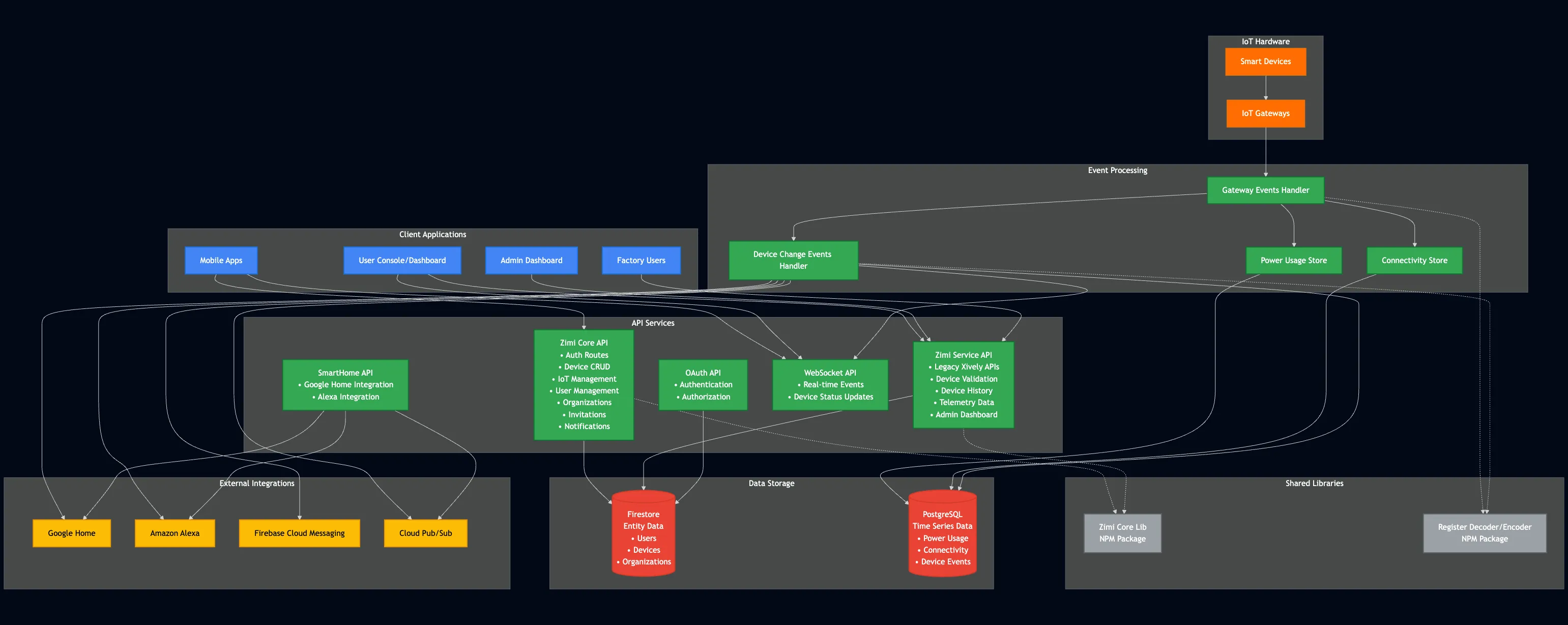Enterprise IoT Cloud Platform Migration
Zero-downtime migration of 55,000+ IoT devices from Xively platform to Google Cloud Platform, achieving 50% cost reduction and 40% latency improvement while maintaining 99.999% uptime.

Technologies
Key Achievements
- Zero downtime migration of 55,000+ active IoT devices
- 50% reduction in infrastructure costs
- 40% improvement in latency
Project Links
Project Overview
The Enterprise IoT Cloud Platform Migration was a critical infrastructure project that involved migrating a large-scale IoT system from the Xively platform to Google Cloud Platform (GCP). This project was essential for improving system performance, reducing costs, and ensuring long-term scalability for smart electrical devices.
The Challenge
The existing system was built on the Xively IoT platform, which had limitations in terms of scalability, cost-effectiveness, and customization options. With 55,000+ active devices generating hundreds of events per second, we needed a solution that could:
- Handle high-volume real-time data processing
- Provide better cost efficiency
- Offer improved latency and reliability
- Support future growth and feature development
- Maintain zero downtime during migration
Architecture & Design
Service-Oriented Architecture
I designed a microservices-based architecture on GCP that emphasized:
- Scalability: Auto-scaling components based on demand
- Reliability: Redundancy and fault tolerance built-in
- Security: End-to-end encryption and secure device communication
- Maintainability: Clear separation of concerns and comprehensive documentation
- Observability: Detailed monitoring and tracing capabilities
Technology Stack
- Cloud Platform: Google Cloud Platform
- Container Orchestration: Kubernetes for scalable deployment
- Database: Cloud SQL (PostgreSQL) for relational data, Redis for caching
- Messaging: PubSub for event-driven communication
- Authentication: Firebase Auth for user management
- Storage: Firestore for device metadata, Cloud Storage for files
- Monitoring: Cloud Monitoring and Trace for observability
Implementation
Phase 1: Research & Planning
- Analyzed existing system architecture and dependencies
- Designed new microservices architecture
- Created comprehensive migration plan
- Set up development and staging environments
Phase 2: Development
- Built new backend services using TypeScript and Node.js
- Implemented REST APIs and event-driven services
- Developed device communication protocols using MQTT
- Created admin dashboards with React/Redux
- Established CI/CD pipelines with Docker and Cloud Build
Phase 3: Testing & Validation
- Performed extensive testing in staging environment
- Validated data integrity and system performance
- Conducted load testing with simulated device traffic
- Verified all integrations including voice control systems
Phase 4: Migration Execution
- Executed zero-downtime migration strategy
- Gradually migrated devices in batches
- Monitored system health throughout the process
- Coordinated with mobile app and firmware development teams
Technical Highlights
Real-time Event Processing
Implemented a robust event processing system capable of handling 100+ events per second from IoT devices, with automatic scaling based on load.
Device Communication Security
Established secure MQTT communication channels with proper authentication and encryption, ensuring device data integrity and privacy.
Monitoring & Observability
Integrated comprehensive monitoring using Cloud Monitoring, custom metrics, and distributed tracing to ensure system health and performance visibility.
Development Efficiency
Created reusable TypeScript/Node.js libraries containing common functionality, reducing development time by more than 50% for future features.
Results & Impact
The migration project delivered significant improvements across multiple dimensions:
Cost Optimization
- Reduced infrastructure costs by 50% through efficient resource utilization
- Eliminated licensing fees from previous platform
- Optimized compute and storage usage patterns
Performance Improvements
- Achieved 40% reduction in average latency
- Improved system responsiveness for end users
- Enhanced real-time data processing capabilities
Reliability & Uptime
- Maintained 99.999% uptime post-migration
- Reduced system downtime incidents by 80%
- Improved disaster recovery capabilities
Development Velocity
- Streamlined development processes with modern CI/CD
- Reduced deployment time from hours to minutes
- Enhanced testing and quality assurance workflows
Knowledge Transfer & Documentation
Recognizing the importance of knowledge sharing, I:
- Documented the entire system architecture with detailed diagrams
- Created comprehensive API documentation
- Conducted knowledge transfer sessions with the development team
- Established best practices for ongoing maintenance and development
Lessons Learned
This project reinforced several key principles:
- Planning is Critical: Thorough planning and testing prevented major issues during migration
- Communication is Key: Regular coordination with all stakeholders ensured smooth execution
- Monitoring is Essential: Comprehensive monitoring helped identify and resolve issues quickly
- Documentation Matters: Detailed documentation facilitated team knowledge transfer and future development
Future Considerations
The new architecture positions the platform for future enhancements:
- Capability to handle millions of devices
- Support for advanced analytics and machine learning
- Integration with additional IoT protocols and standards
- Enhanced real-time dashboard capabilities
This project demonstrates the successful execution of a complex cloud migration while maintaining business continuity and achieving significant improvements in performance, cost, and reliability.